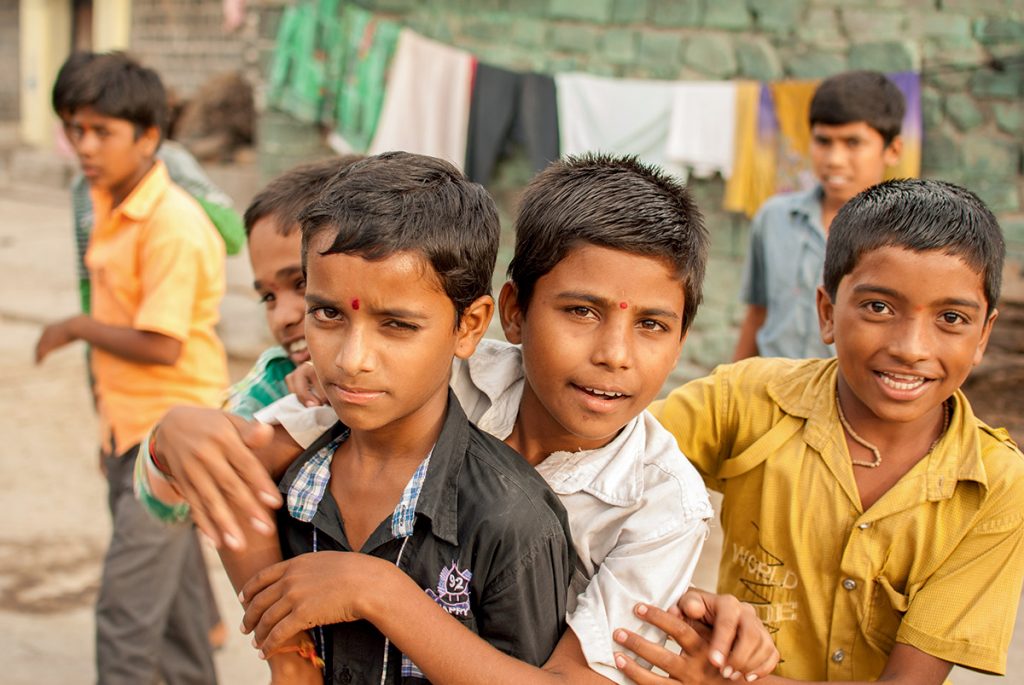Society
Cosmetics: A Deep Dive Into The Ethics of Mica
Mica is a mineral used for many purposes, including the making of shimmery cosmetics like blush, lipstick, and highlighter. But the ethics of this natural material are far from glowing, especially for the workers, and more specifically, the child labour victims who extract it. Let’s take a closer look.
by : ELISABETH MASSICOLLI- Jul 5th, 2021

Beauty Counter
Vegan, cruelty-free, natural, organic, eco-friendly: in the world of beauty, these keywords have become strong selling points. Beautistas and consumers in general have increasing awareness of their purchasing power. They weigh the pros and cons not only in terms of results, but also ethics. That’s for the better, but we should be careful. A product can be “natural” or “not tested on animals” and still present a questionable moral choice. Why? In part because its raw ingredients may have been extracted in highly precarious working conditions.
One such problematic substance is mica, a mineral mainly mined in India and Madagascar, and solicited for its shimmering effect. It’s not only used to create many cosmetic products – like eye shadow, highlighter, shampoo, and gloss – but also electronics, paints, and pigments needed for large-scale productions by the automobile industry. In and of itself, mica is a natural and relatively safe ingredient for human health; no need to sound the alarm. The problem is in how this mineral is sourced.
Perfectly illegal
India is not the only country where mica can be found, but it is one of the most important suppliers in the world, especially when it comes to beauty products. Close to 60 percent of the high-quality mica used in cosmetics comes from two north-eastern Indian states – Bihar and Jharkhand – the country’s so-called “mica belt” on account of the region’s abundance of the mineral. For reasons related to forest protection, most mica mines in these states are operated illegally. As a result, the working conditions there are difficult – if not impossible – to regulate, leading to a great number of oversights. On top of the low wages earned and the dangers encountered by workers, these mines, which greatly vary in size and are often found near the poorest villages, exploit children who are sometimes just five years old. According to the Centre for Research on Multinational Corporations (SOMO), close to 22,000 children work long hours in the mines of these two states to help their families make ends meet, often putting their lives at stake. In communities where decent work opportunities are cruelly lacking, they often have no choice. Since all of this is perfectly illegal, incidents are quickly brushed under the table, and it becomes hard to find accurate stats on the subject. According to some reports, between 10 and 20 people die each month while mining mica, including children. But we have no data regarding injuries. It’s even been reported that the operators of these mines offer financial compensation – equivalent to approximately $500 – to the families who’ve lost a loved one in the mines in exchange for their silence.
The mineral excavated by the workers and child workers goes through many hands before landing in our beauty products. It’s collected by an intermediary, who sells it to an exporter, who then delivers it to a manufacturer, often located in China. It’s then moulded into a pearly pigment, and sold to international companies. This long supply chain, more or less legal, clouds the exact origins of the mica and enables human exploitation. All of this is done to maintain low costs and high profits. According to sources, there are only up to three legally operated mines in the states of Bihar and Jharkhand, with less complex supply chains, but they are far, far from the norm.
 Responsible Mica Initiative
Responsible Mica InitiativeChildren from the mining community of Jharkhand.
A light at the end of the tunnel
Despite this opacity, the problems surrounding the supply of mica have been discussed by the media since 2014. A documentary and in-depth reporting produced by the American webzine Refinery29, which travelled to India in 2019 to meet young mica mine workers, provoked a wave of shock among consumers of beauty products. Several cosmetics companies quickly announced their commitment to using “ethical” mica. And to give credit where credit is due, it’s true that many beauty businesses have committed to sourcing the mineral as responsibly as possible. Many are members of the Responsible Mica Initiative (RMI), a non-profit created in 2016 with the goal of establishing a responsible and ethical supply chain in India, and eradicating child work in mica mines by 2022. “We’re working on three pillars”, explains Fanny Frémont, director of the RMI. “The first touches on supply chain mapping and workplace standards; in brief, we want to help establish best practices in India’s workplace environments, from mines to subcontractors to exporters. A better understanding of supply chains, from beginning to end, helps us figure out where to focus our efforts.” The second pillar is community empowerment, with the goal of improving living conditions for families and getting children out of the mines, by looking at the profound roots of the problem – including poverty and lack of access to education. “We’re collaborating with seven local NGOs in 80 villages to find new sources of revenue for families, reduce their health expenses, and help make school an attractive opportunity for children”, Frémont said. Finally, the RMI concentrates on the legal frameworks of India’s mica industry. “Our role is to bring together all the stakeholders – governments, NGOs, committees, suppliers, and companies – to create laws, regulations, and related enforcement mechanisms that will govern all aspects of the mica industry”, Frémont added.
And they’re not bluffing. According to Claire van Bekkum, senior project manager for Terre des Hommes Netherlands, an NGO that campaigns for sustainable development and to stop child exploitation, the RMI is much more than a good name to hammer into press releases.
With the help of its members, this organization is making a real difference in the concerned communities. “Things are changing quickly”, van Bekkum said. “In the last few months, we’ve observed close to 9,000 children returning to school. That doesn’t mean they’re no longer working in mines, but it’s a step forward. Since child labour is illegal in India, and since these children live in extremely secluded communities, it’s difficult to obtain accurate statistics, but the number of children receiving an education is a good indication that their living conditions are improving.”
In the RMI’s list of 55 members, you’ll find familiar names: Chanel, Estée Lauder, Clarins, Shiseido, Sephora, and L’Oréal, among others. This last conglomerate – which owns brands like Maybelline, Urban Decay, Essie, NYX, and more – when asked about the topic, states that “98 percent of their raw materials containing natural mica comes from safe sources, meaning from suppliers who can offer complete traceability of their supply chains, and who are committed to preventing child labor. We’re actively working towards reaching 100 percent.” This percentage is however contested by Terre des Hommes, which stated in a 2018 report that it is still impossible to claim with certainty that natural mica from India isn’t stained by child labor. “There are too many actors involved in the process, and it remains an illicit activity”, says van Bekkum. “It’s hard to honestly claim that you only use mica exempt of child labor because… we just don’t know! Somewhere in the long supply chain, our mica may have been legalized on paper, but in the field, we’re still unsure of anything.” Still, the cosmetics industry is well and truly trying to have regulations implemented that would improve living and working conditions for the communities who depend on mica mines. “There’s a real interest coming from large conglomerates like L’Oréal. They’ve become experts in the matter and are proactive about it. Perhaps their motivation stems from the fact that mica is listed as an ingredient on many of their products, in plain view, as opposed to the automobile and electronic industries. Be that as it may, thanks to their knowledge and efforts, there have been real advancements for mining communities,” van Bekkum says.
Digging for solutions
In 2018, Lush made a commitment to stop using natural mica in its products, to completely remove itself from the Indian market, and to instead use synthetic mica made in environmentally friendly laboratories. The intention, according to a press release, was to guarantee total transparency in its entire supply chain. “The magnitude of the issue combined with our relatively small buying power and the fact that we were advised not to visit without armed accompaniment meant we did not feel that we had the influence to drive the improvements needed”, reads the statement on the company’s website.
No longer purchasing natural mica, boycotting products that contain the mineral… is that the right way to fix the problem? Not at all, according to van Bekkum, although the intention is good. “I was disappointed by Lush’s decision. Mining mica is the only way to generate revenue for communities in Bihar and Jharkhand. If we take away this money-maker, how will they survive? Companies that continue to source mica from there, as well as the ones who have done it in the past, have a responsibility towards these communities to invest in their future, correct and prevent the negative impacts of mine working, and collaborate with workers to improve their living conditions.” In other words, if large corporations remove themselves entirely from the Indian market, the situation could worsen for the affected communities. In its statement to Refinery29, L’Oréal said: “We believe that discontinuing the use of Indian mica would further weaken the local situation. L’Oréal is committed to the continued sourcing [of] natural mica from India in order to allow already impoverished communities to keep generating income.” The best way forward for companies is to act in unison with NGOs, governments, and workers, using their purchasing power to establish standard working conditions and regulate the entire sector, while improving the living conditions of communities.
The efforts made by all the stakeholders seem to be bearing fruit. Some mines are now legally operated, thousands of children have returned to school, and consumers are increasingly aware of the issue and applying pressure to the different industries profiting from the use of mica. “I’m seeing real change and a glimmer of hope”, says van Bekkum.
If you’re a fan of shiny things, you can contribute to the battle against human exploitation by educating yourself, supporting organizations like Terre des Hommes, and demanding transparency from your favorite brands regarding their supply of mica. A brilliant (!) way of doing your part.
A wind of change
For two years, the American cosmetics company Beautycounter has been doing its part by breaking down every step of its mica supply chain. To do so, it conducts audits on mining sites in Jharkhand to help eradicate child labor by working alongside local communities and in collaboration with
Kailash Satyarthi, co-recipient of the 2014 Nobel Peace Prize. And by the end of 2020, Beautycounter plans to provide an interactive map on its website so that consumers can see in real time where the mica used in its products is being sourced.
To find out more about this initiative, watch the YouTube documentary that explains the brand’s process (@Beautycounter) or visit the website, Beautycounter.com
For more info
Responsible Mica Initiative
Responsible-mica-initiative.com
Terre des Hommes Netherlands
terredeshommes.nl
Read more:
Change a Girl’s Life: How You Have the Power to Make a Difference
Here’s How You Can Be a Genuine Ally to Indigenous Communities in Canada
Movies, Podcasts and Books to Educate Yourself on Climate Change, Sustainability and the Hunger Crisis
Newsletter
Join our mailing list for the latest and biggest in fashion trends, beauty, culture and celebrity.
Read Next

Beauty
Dyson Just Launched Its Most Intelligent Hair Dryer Yet
Get ready to upgrade your blowout game.
by : Lauren Knowles- Apr 25th, 2024

Fashion
Meredith Shaw Created a Plus-Size Summer Dress Collection That "Feels Like Candy"
The morning show host joined forces with PENN. to create a curated collection for sizes 14-32.
by : Allie Turner- Apr 25th, 2024

Culture
This University Elevates Women to New Professional Heights
You shouldn’t have to pause your life to move forward in your career.
by : ELLE Canada- Apr 16th, 2024




